Multimeter (Types, Applications, How to Choose)
A multimeter is a multi-functional electronic device that can be used to measure parameters such as resistance, voltage, electric current, and frequency in various circuits as well as electronic components. Since multimeters can measure these parameters may also be known as a volt-ohm meter or volt-ohm-milliammeter.
The main function of a multimeter is measuring the characteristics of an electric signal. It is a standard diagnostic device for technicians in the electrical/electronic industries.
A multimeter is also called an AVO meter because it can measure Volt, Ampere, and Ohm.
This device is one of the tools used by electricians to troubleshoot electrical problems in motors, electric appliances, circuits, power supplies, and wiring systems and plays a key role in assembling and setting up electric systems and equipment in buildings, manufacturing electronic goods, and metrological inspection of measuring devices.
Browse our wide selection of Multimeter products category with the highest quality.
How many types of Multimeters are there?
There are two types of multimeters depending on their output display: digital multimeters and analog multimeters.
Analog Multimeter
Analog multimeters are old-fashioned meters that indicate the measured value with a needle on an analog scale.
They are a preferred choice when high precision and power consumption from the built-in power supply in the mode of voltage and current measurement is not required.
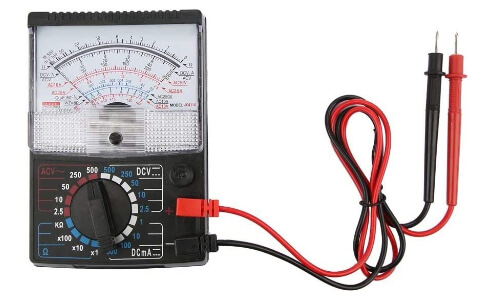
Digital Multimeter
Digital multimeters are modern and reliable measuring devices that convert the analog input into digital and display the measured value in digit form.
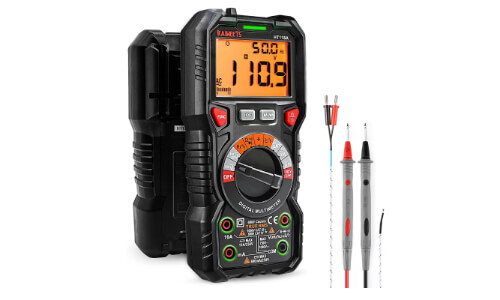
Digital devices feature high measurement accuracy and various functional capabilities. This multimeter performs all functions from AC to DC other than analog.
Today most multimeters are produced in digital form. Specialists working with electrical equipment, if necessary, can select a model of the digital multimeters focused on a specific task.
What is the difference between Analog Multimeter and Digital Multimeter?
Some of the main differences between analog and digital multi meter are explained in the following:
| Analog Multimeter | Digital Multimeter |
| Analog Multimeter is used to measure limited electrical quantities like resistance, voltage & current | Digital Multimeter is used to measure different electrical quantities such as voltage, current, capacitance, resistance, and values of diode and impedance, etc. |
| The analog multimeter is larger in size | The digital multimeter is smaller in size |
| This meter displays the measured value on a scale next to the pointer | This meter displays the measured value in the form of numeric on an LCD |
| This device is calibrated manually | This device is calibrated automatically |
| It has a simple construction | It has a complicated construction because of the using of components such as electronics and logic |
| Less accurate | Very accurate |
|
It provides less electric noise |
It provides more electric noise |
|
The meter doesn’t need ADC to display reading |
The meter needs ADC to show reading |
What are the different types of a digital multimeter?
Digital multi meters or DMMs are the best friends of an electrician. Different kinds of DMMs are available due to the range of operation these devices provide.
Simple Digital Multimeter
Simple digital multimeters are used for various calibration activities. They calibrate electric current, voltage and resistance, and other electrical units across different components.
A Fluke DMM consists of a large display screen, making it very easy to get the readings. Some innovative DMMs can measure temperature, frequency, pressure, humidity, and duty cycle.
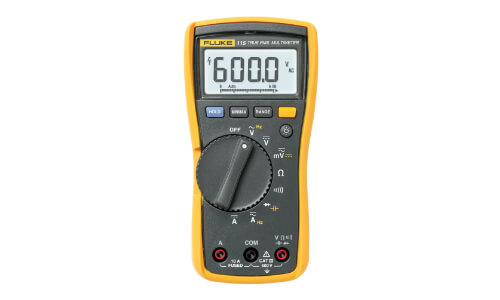
The voltage, current, or resistance reading is measured when the two leads are connected to the device. Also, because of its capacity to calibrate electrical units, it has advantages over other types of digital multimeters.
Digital Clamp Meter
A digital clamp meter (clamp multimeter) is a measuring device with built-in tools used to measure electrical flow. The main purpose of a clamp DMM is to read amperage that is surging through an insulated cable and the circuit’s voltage.
Normally, most digital clamp meters can not measure electrical resistance.
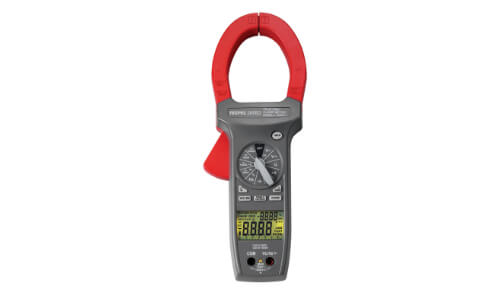
They normally measure current flow through the clamp portion and the volts using the probes. The power consumption, or Watts, can be calibrated by multiplying the amps and the readings of the volt.
It is only recommended for use by trained professionals.
Our clamp meter category includes high-quality products. Check it now.
Auto ranging Multimeter
Auto-ranging Multimeter is another type of digital multimeter that adjusts automatically and can automatically switch their ranges based on what value they measure.
This digitized measurement tool is designed to make projects easier to complete. This measurement method is more suitable for Electricians and DIY enthusiasts to conduct their own electrical projects in their homes.
That’s because it only measures one component at a time. Also, this digital flow meter is categorized as a type of focus tool.
Different parts of a Multimeter
Each digital multimeter consists of the four main parts:
Display: The amount of measured value is displayed in this area.
Selector knob or selector switch: By turning the selector key, the desired parameter (voltage, current, and resistance) can be selected.
Port: Port or input terminal is the hole at the front of the multimeter. You need to connect your test probes to the appropriate ports to allow the multimeter to measure the desired parameter.
Test Probes: A test probe or a test lead is a device used to connect a multimeter to a Device Under Test which is known as DUT. All multimeters have two probes, One group is red which connects to the positive terminal and the other is black which connects to the negative terminal.
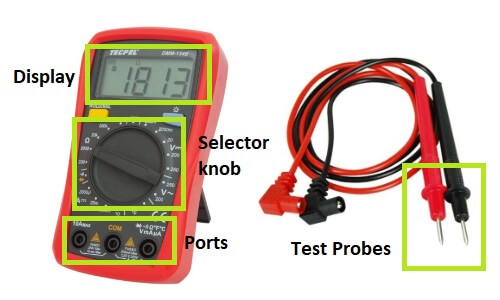
A brief look at multimeter use
1.
Automotive Inspection: One of the most important applications of multimeters is the automotive service.
Measuring battery charge, running a leak test on its cover, testing the alternator, and inspecting the car horn or any other electrical circuit in your system is the function of the multimeter. It's an essential device for automotive technicians.
2. Household Applications: A multimeter is essential in every home. With a multimeter, you can Test faulty sockets, check continuity, inspect home appliances, and test the rest of the circuits in your house. Although there is no brand specially designed multimeter for home use, a multimeter capable of measuring key parameters will work.
3. Industrial Applications: There is a wide range of applications for Multimeters in industrial activities. Engineers need to use multimeters in their tasks to measure the temperature of instruments, conduct continuity tests, evaluate current flow, or analyze circuits via infrared imaging. Some modern multimeters are designed to send live feeds wirelessly.
4. DIY Applications: Everyone interested in DIY electronic projects are widely used multimeters. by using a multimeter they can perform experiments at home easily. Since there is no high-end testing required, basic multimeters are most suitable for DIY project applications. So they are relatively inexpensive compared to other applications.
Which multimeter do I need?
Multimeters are electronic tools that measure voltage, current, and resistance. Although there are many different types of multimeters with various functions and advantages.
When you need to choose the right multimeter for your needs, you should pay attention to its properties, and determine what you would use it for and how often it would be utilized.
So many good multimeters are available out there, and you need to do a little comparison between available models to see which type operates the way you want it to. First, you should learn more about these handy devices. Merchant websites are great to see product reviews and talk to employees about different options of a multimeter.
Next, find what types of multimeters are suitable for your needs. There are many different types of multimeters to meet the needs of any kind of user. Then, consider which multimeter features are key.
Some of the features that everyone should notice before buying a multimeter are whether an analog multimeter suits your needs or a digital multimeter with advanced features and determining the demanding accuracy of the meter. Also, types of manufacturers are important to look at when choosing a multimeter.
Questions
What are multimeters used for?
A multimeter is test equipment used to measure two or more electrical values— voltage, current, and resistance. It is a standard diagnostic device for technicians in the electrical/electronic industries.
Are all digital multimeters the same?
No. Many digital multimeters have the same features and functions, but there are many models with certain features and uses.
What are the advantages of a digital multimeter?
- Their accuracy is more than analog multimeters.
- They reduce reading and interpolation errors.
- The 'auto-polarity' function can avoid problems from connecting the meter to a test circuit with the wrong polarity.
- Parallax errors are removed.
The following articles may be of interest to you if you would like to read more:
Sound Level Meter (How It Works, Classes, Differences And Applications)
Tachometer (Working Principle, Types, Applications)
Recent Posts
-
Booster Pump Troubleshooting and Maintenance: How to Fix and Prevent Common Issues
1. Introduction Imagine turning on your faucet only to be greeted with a weak trickle of water when …22nd Apr 2025 -
Energy-Efficient Booster Pumps: Selection and Tips for Maximizing Performance
1. Introduction Imagine never having to deal with fluctuating water pressure, noisy pumps, or skyroc …19th Apr 2025 -
Booster Pumps for Sustainable Water Systems: Irrigation and Rainwater Harvesting Solutions
1. Introduction Water scarcity is no longer a distant threat—it’s a reality affecti …16th Apr 2025




